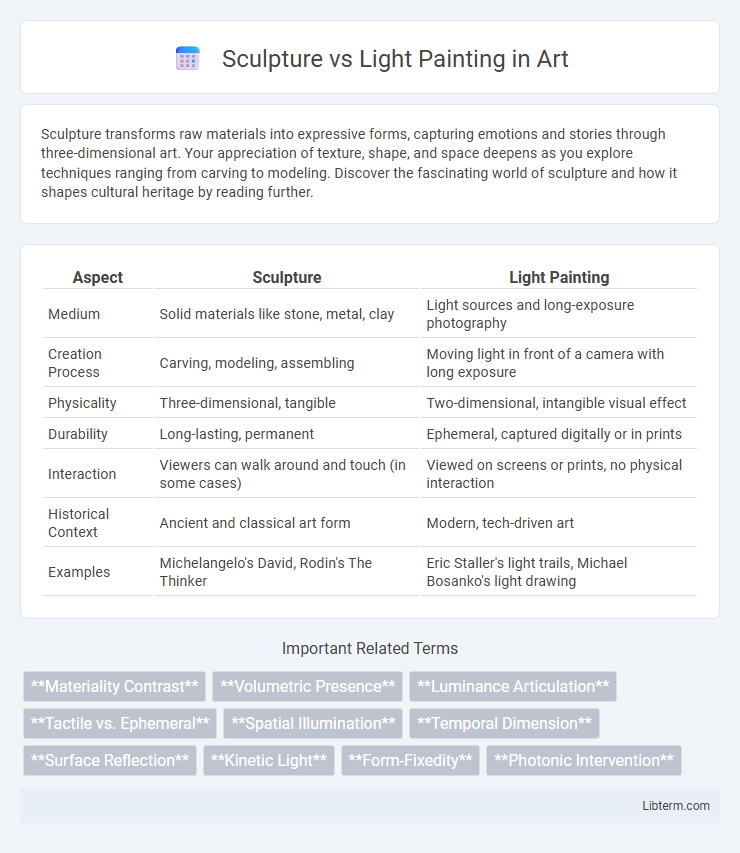Sculpture transforms raw materials into expressive forms, capturing emotions and stories through three-dimensional art. Your appreciation of texture, shape, and space deepens as you explore techniques ranging from carving to modeling. Discover the fascinating world of sculpture and how it shapes cultural heritage by reading further.
Table of Comparison
| Aspect | Sculpture | Light Painting |
|---|---|---|
| Medium | Solid materials like stone, metal, clay | Light sources and long-exposure photography |
| Creation Process | Carving, modeling, assembling | Moving light in front of a camera with long exposure |
| Physicality | Three-dimensional, tangible | Two-dimensional, intangible visual effect |
| Durability | Long-lasting, permanent | Ephemeral, captured digitally or in prints |
| Interaction | Viewers can walk around and touch (in some cases) | Viewed on screens or prints, no physical interaction |
| Historical Context | Ancient and classical art form | Modern, tech-driven art |
| Examples | Michelangelo's David, Rodin's The Thinker | Eric Staller's light trails, Michael Bosanko's light drawing |
Introduction to Sculpture and Light Painting
Sculpture, a traditional form of three-dimensional art, involves shaping materials like stone, metal, or wood to create physical objects that occupy space and engage viewers through texture and form. Light painting is a contemporary photographic technique where moving light sources are captured with long-exposure cameras, producing luminous designs and abstract images in a two-dimensional medium. Both art forms explore spatial perception but differ fundamentally in materiality and temporal experience.
Historical Evolution of Both Art Forms
Sculpture dates back to prehistoric times, evolving through cultures like Ancient Egypt, Greece, and the Renaissance, emphasizing physical form and three-dimensional artistic expression. Light painting emerged in the 20th century with advancements in photography and artificial light, pioneered by artists such as Man Ray and Pablo Picasso to create dynamic, immaterial images using long-exposure techniques. Both art forms reflect technological influences and cultural shifts, with sculpture rooted in tactile craftsmanship and light painting embodying ephemeral, experimental visual art.
Techniques in Sculpture Creation
Sculpture creation employs techniques such as carving, modeling, casting, and assembling to transform materials like stone, metal, clay, and wood into three-dimensional artworks. Artists utilize tools ranging from chisels and hammers for subtractive methods to molds and welding equipment for additive processes, allowing precise control over texture, form, and detail. Mastery of these traditional and contemporary techniques enables sculptors to manipulate volume and mass, creating tactile and durable pieces that contrast with the ephemeral and dynamic nature of light painting.
Methods and Tools in Light Painting
Light painting utilizes long-exposure photography combined with handheld light sources such as LEDs, flashlights, and fiber optics to create dynamic, luminous images in dark environments. Artists manipulate these light tools by moving them through space during the camera's exposure time, effectively "painting" images or patterns of light captured in the photograph. Unlike traditional sculpture, which relies on physical materials like clay, metal, or stone shaped with tactile tools, light painting depends on digital cameras, tripods, and programmable light instruments to create ephemeral, intangible art.
Materiality vs. Intangibility
Sculpture embodies tangible materiality through physical substances like stone, metal, or wood, offering a sensory experience grounded in weight, texture, and volume. Light painting, by contrast, transcends physical form with ephemeral, intangible light trails captured via long-exposure photography, emphasizing temporality and movement over solidity. This contrast highlights sculpture's permanence against light painting's transient, immaterial essence.
Expression of Space and Dimension
Sculpture manipulates physical materials to create tangible three-dimensional forms that occupy actual space, allowing viewers to perceive volume, texture, and spatial relationships directly. Light painting, on the other hand, uses time-based photography techniques to trace or illuminate space with ephemeral lines and shapes, producing an intangible dimension of perceived depth and motion within a two-dimensional medium. Both art forms explore and challenge the viewer's understanding of space and dimension, with sculpture emphasizing physical presence and permanence, while light painting captures transient light patterns that suggest spatial complexity beyond solid form.
Interaction with Light and Shadow
Sculpture manipulates light and shadow by its three-dimensional form, creating dynamic patterns and depth that change with the viewer's perspective and light source position. Light painting captures movement of light in a photograph, producing ephemeral, glowing shapes that interact with the surrounding darkness to create contrast and visual interest. Both art forms rely on the interplay of illumination and shadow, but sculpture emphasizes physical presence while light painting focuses on temporal light trajectories.
Audience Experience and Engagement
Sculpture offers a tactile, three-dimensional presence that invites viewers to physically navigate around the artwork, fostering a deep spatial awareness and intimate connection through texture and form. Light painting, by contrast, captivates audiences with dynamic, ephemeral visuals that evolve in real-time or through long-exposure photography, eliciting a sense of wonder and participation in the creative process. The interactivity inherent in light painting often encourages audience involvement, transforming viewers into active contributors, whereas sculpture engages through focused observation and contemplation.
Contemporary Innovations in Both Art Forms
Contemporary innovations in sculpture incorporate interactive elements and mixed media, merging traditional materials like metal and stone with digital technology and augmented reality to create immersive experiences. Light painting advances through the integration of programmable LEDs, drones, and long-exposure photography, allowing artists to manipulate light as a dynamic medium in both physical and virtual spaces. Both art forms push boundaries by blending physical presence with ephemeral effects, challenging perceptions of form, space, and temporality in modern artistic expression.
Conclusion: Comparing Impact and Artistic Potential
Sculpture offers a tangible, three-dimensional form that occupies physical space, allowing viewers to engage with texture, weight, and materiality, making it enduring and tactile. Light painting, as a photographic art form, captures ephemeral movement and color, creating dynamic and visually striking images that emphasize light's transient nature. Both mediums push artistic boundaries, but sculpture's permanence contrasts with light painting's fleeting, momentary impact, highlighting their unique potentials in expressing creativity and emotion.
Sculpture Infographic

 libterm.com
libterm.com